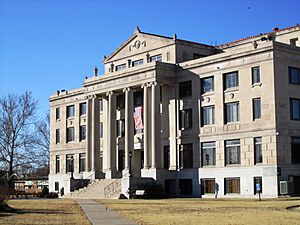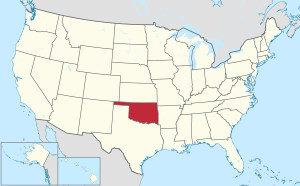Kay County, Oklahoma facts for kids
Quick facts for kids
Kay County
|
|
|---|---|

Kay County Courthouse in Newkirk (2010)
|
|

Location within the U.S. state of Oklahoma
|
|
 Oklahoma's location within the U.S. |
|
| Country | |
| State | |
| Founded | 1893 |
| Seat | Newkirk |
| Largest city | Ponca City |
| Area | |
| • Total | 945 sq mi (2,450 km2) |
| • Land | 920 sq mi (2,400 km2) |
| • Water | 25 sq mi (60 km2) 2.7%% |
| Population
(2020)
|
|
| • Total | 43,700 |
| • Density | 46.24/sq mi (17.855/km2) |
| Time zone | UTC−6 (Central) |
| • Summer (DST) | UTC−5 (CDT) |
| Congressional district | 3rd |
Kay County is a place in the state of Oklahoma, USA. In 2020, about 43,700 people lived there. Its main town is Newkirk. The biggest city is Ponca City.
Kay County is part of the Ponca City area. It's in north-central Oklahoma, right next to the Kansas border. Before Oklahoma became a state, this area was called the "Cherokee Outlet". It was first known as county "K". Kay County is special because it's the only county that kept its original name when Oklahoma changed from a territory to a state.
Contents
History of Kay County
Early Native American Settlements
Long ago, in the 1700s, two big villages of Wichita Native Americans were located in Kay County. These villages were found near the Arkansas River. Later, in the late 1700s and early 1800s, the Osage people used Kay County for hunting.
In 1825, the Osage gave up their rights to a large area of land, including Kay County, to the U.S. government. The government then gave this land to the Cherokee people. This happened after the Cherokee moved to Oklahoma in the 1830s.
Arrival of Other Tribes and Land Run
After the Civil War, the Cherokee Nation had to let the government move other Native American tribes onto their land. This area was known as the Cherokee Outlet. The Kansa (Kaw) tribe arrived in June 1873. They settled in what is now the northeastern part of Kay County. The Ponca tribe came next in 1877.
The Nez Perce tribe came from the Pacific Northwest in 1879. However, they only stayed until 1885. Then, they returned to their homeland. Their land in Oklahoma was later used by the Tonkawa and Lipan Apache people tribes.
Most of Kay County was opened for new settlers in 1893. This happened during the Cherokee Strip Land Run. Thousands of people rushed into Kay County to claim free land.
Chilocco Indian Agricultural School
The Chilocco Indian Agricultural School was north of Newkirk. It was a boarding school for Native American students. The school operated from 1884 to 1980. At its busiest in the 1950s, it had 1,300 students. Graduates from this school came from 126 different Native American tribes. The school's old buildings were built using local limestone.
Recent Developments
In 2010, the Keystone Pipeline (Phase II) was built through Kay County. It runs from north to south, heading towards Cushing.
On September 17, 2024, the National Park Service made an exciting announcement. Kay County and Ponca City were both named a World War II Heritage City. This honor recognizes their important contributions during World War II.
Geography and Landscape
Kay County covers about 945 square miles. About 25 square miles of this area is water. The highest point in Kay County is about 1,310 feet above sea level. The lowest point is 891 feet, where the Arkansas River leaves the county.
The northern edge of Kay County borders Kansas. Its eastern border is with Osage County. Kaw Lake is a large lake on the Arkansas River. It was finished in 1975 and covers most of the county's water area.
East of Kaw Lake and the Arkansas River, you'll find the Osage Hills. This area is a tall-grass prairie with many large ranches. Most of these ranches raise cattle. West of the Arkansas River, the land is flatter. It has a mix of farms and livestock ranches. The main rivers flowing through the county are the Chikaskia River, the Arkansas River, and the Salt Fork of the Arkansas River.
Major Roads in Kay County
Neighboring Counties
- Cowley County, Kansas (north)
- Garfield County (southwest)
- Grant County (west)
- Noble County (south)
- Osage County (east)
- Sumner County, Kansas (north)
Population and People
| Historical population | |||
|---|---|---|---|
| Census | Pop. | %± | |
| 1900 | 22,530 | — | |
| 1910 | 26,999 | 19.8% | |
| 1920 | 34,907 | 29.3% | |
| 1930 | 50,186 | 43.8% | |
| 1940 | 47,084 | −6.2% | |
| 1950 | 48,892 | 3.8% | |
| 1960 | 51,042 | 4.4% | |
| 1970 | 48,791 | −4.4% | |
| 1980 | 49,852 | 2.2% | |
| 1990 | 48,056 | −3.6% | |
| 2000 | 48,080 | 0.0% | |
| 2010 | 46,562 | −3.2% | |
| 2020 | 43,700 | −6.1% | |
| U.S. Decennial Census 1790-1960 1900-1990 1990-2000 2010 |
|||
In 2000, there were 48,080 people living in Kay County. About 19,157 households and 13,141 families called it home. The population density was about 52 people per square mile. There were 21,804 housing units, with an average of 24 units per square mile.
Most people in the county were White (84.16%). There were also Black or African American (1.79%), Native American (7.53%), and Asian (0.53%) residents. About 4.25% of the population was Hispanic or Latino. By 2020, the total population had changed to 43,700 people.
In 2000, about 31.90% of households had children under 18 living with them. About 54.70% were married couples. The average household had 2.45 people. The average family had 2.99 people.
The population was spread out by age. About 26.40% were under 18. About 17.00% were 65 or older. The average age was 38 years old. For every 100 females, there were about 93.70 males.
In 2000, the average income for a household was $30,762. For a family, it was $38,144. The average income per person in the county was $16,643. About 16.00% of the population lived below the poverty line. This included 22.70% of those under 18. In 2021, the average household income was $50,391.
Communities in Kay County
Cities
- Blackwell
- Kaw City
- Newkirk (This is the county seat, or main town.)
- Ponca City (This is the biggest city. Part of it is also in Osage County.)
- Tonkawa
Towns
Other Communities
- Nardin
- Peckham
- Tonkawa Tribal Housing
- White Eagle
- Chilocco (This is an unincorporated community.)
Notable People from Kay County
- Joseph James: A mixed-blood Kaw Native American who passed away in Kay County in 1898.
- Les Layton: A baseball player.
- Jim Reese: Born in Kay County around 1957. He used to be a member of the Oklahoma House of Representatives. Since 2011, he has been the commissioner of the Oklahoma Department of Agriculture.
- E.W. Marland: The 10th Governor of Oklahoma and a U.S. Congressman. He was an oil tycoon who made and lost a lot of money in the Oklahoma oil fields.
- The Miller Brothers: Joseph, George, and Zack. They inherited the famous 101 Ranch from their parents, G.W. and Molly Miller. Their parents encouraged them to think big.
- Lew Wentz: An oil tycoon and a person who gave a lot of money to good causes (philanthropist).
See also
 In Spanish: Condado de Kay para niños
In Spanish: Condado de Kay para niños

